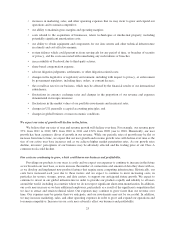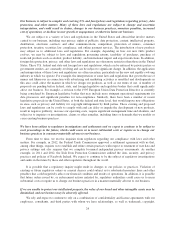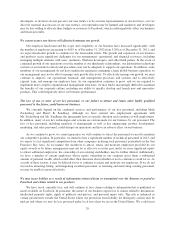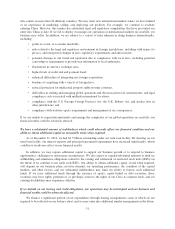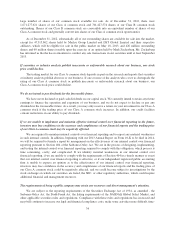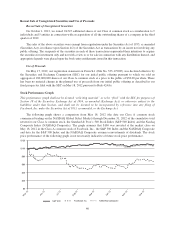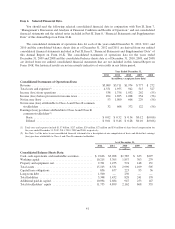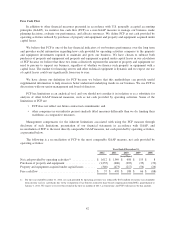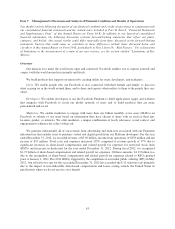Facebook 2012 Annual Report Download - page 37
Download and view the complete annual report
Please find page 37 of the 2012 Facebook annual report below. You can navigate through the pages in the report by either clicking on the pages listed below, or by using the keyword search tool below to find specific information within the annual report.Risks Related to Ownership of Our Class A Common Stock
The trading price of our Class A common stock has been and will likely continue to be volatile.
The trading price of our Class A common stock has been, and is likely to continue to be, volatile. Since
shares of our Class A common stock were sold in our IPO in May 2012 at a price of $38.00 per share, our stock
price has ranged from $17.55 to $45.00 through December 31, 2012. In addition to the factors discussed in this
Annual Report on Form 10-K, the trading price of our Class A common stock may fluctuate significantly in
response to numerous factors, many of which are beyond our control, including:
• actual or anticipated fluctuations in our revenue and other operating results;
• the financial projections we may provide to the public, any changes in these projections or our failure
to meet these projections;
• actions of securities analysts who initiate or maintain coverage of us, changes in financial estimates by
any securities analysts who follow our company, or our failure to meet these estimates or the
expectations of investors;
• additional shares of our common stock being sold into the market by us or our existing stockholders or
the anticipation of such sales;
• investor sentiment with respect to our competitors, our business partners, and our industry in general;
• announcements by us or our competitors of significant products or features, technical innovations,
acquisitions, strategic partnerships, joint ventures, or capital commitments;
• announcements by us or estimates by third parties of actual or anticipated changes in the size of our
user base, the level of user engagement or the effectiveness of our ad products;
• changes in operating performance and stock market valuations of technology companies in our
industry, including our Platform developers and competitors;
• price and volume fluctuations in the overall stock market, including as a result of trends in the
economy as a whole;
• media coverage of our business and financial performance;
• lawsuits threatened or filed against us;
• developments in new legislation and pending lawsuits or regulatory actions, including interim or final
rulings by judicial or regulatory bodies; and
• other events or factors, including those resulting from war or incidents of terrorism, or responses to
these events.
In addition, the stock markets have experienced extreme price and volume fluctuations that have affected
and continue to affect the market prices of equity securities of many technology companies. Stock prices of many
technology companies have fluctuated in a manner unrelated or disproportionate to the operating performance of
those companies. Following our IPO, the events surrounding the offering became the subject of securities
litigation. We may experience more such litigation following future periods of volatility. Any securities litigation
could subject us to substantial costs, divert resources and the attention of management from our business, and
adversely affect our business.
Substantially all of our total outstanding shares are available for sale into the public market and any
substantial sales of our stock could cause the price of our Class A common stock to decline.
The price of our Class A common stock could decline if there are substantial sales of our common stock,
particularly sales by our directors, executive officers, employees, and significant stockholders, or when there is a
33


